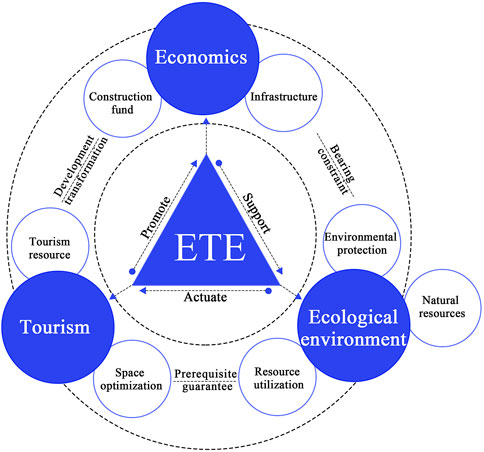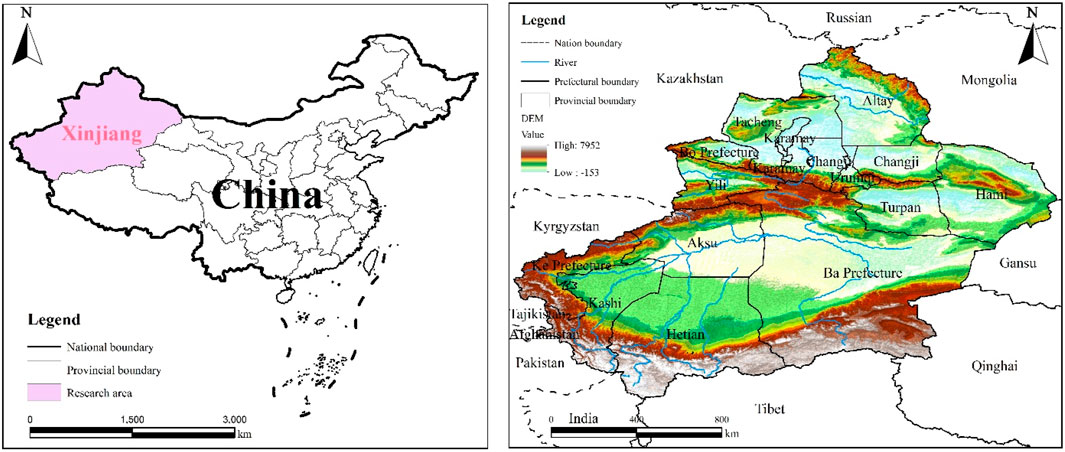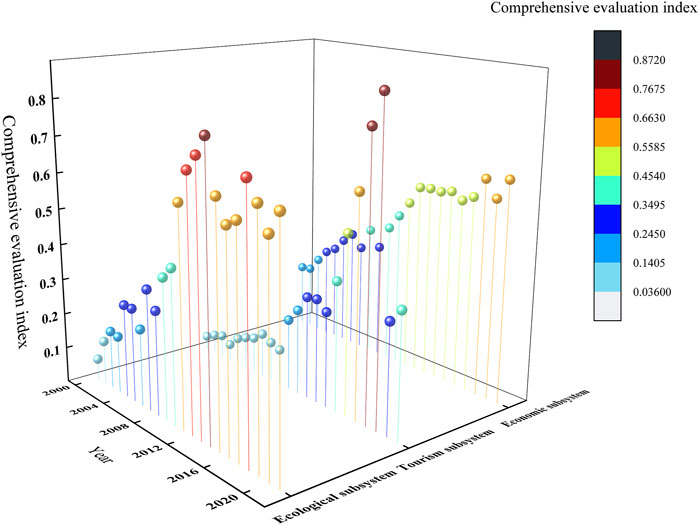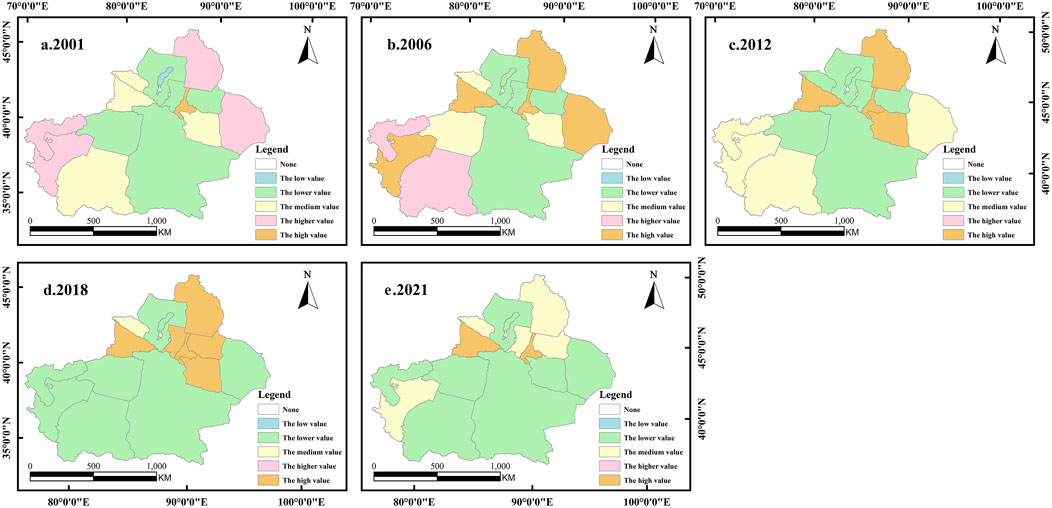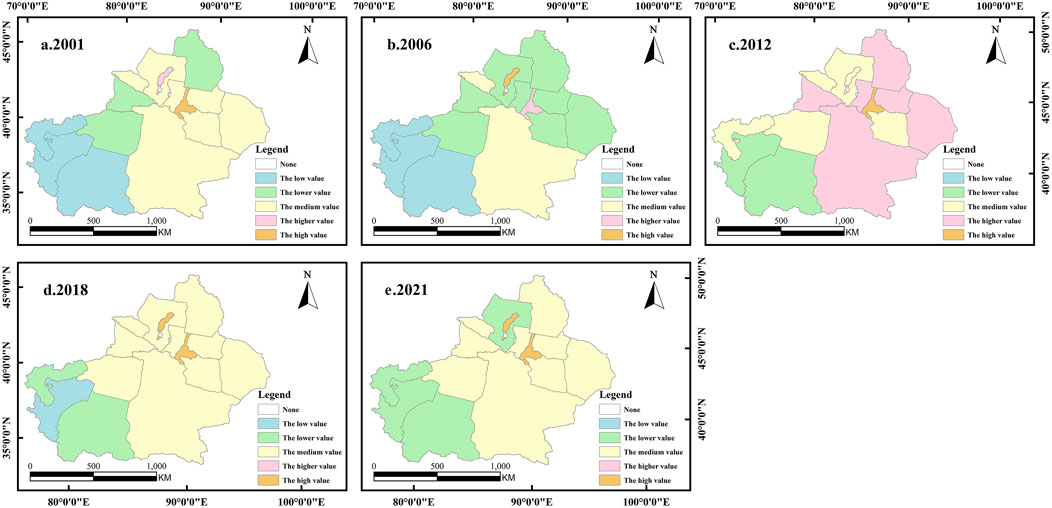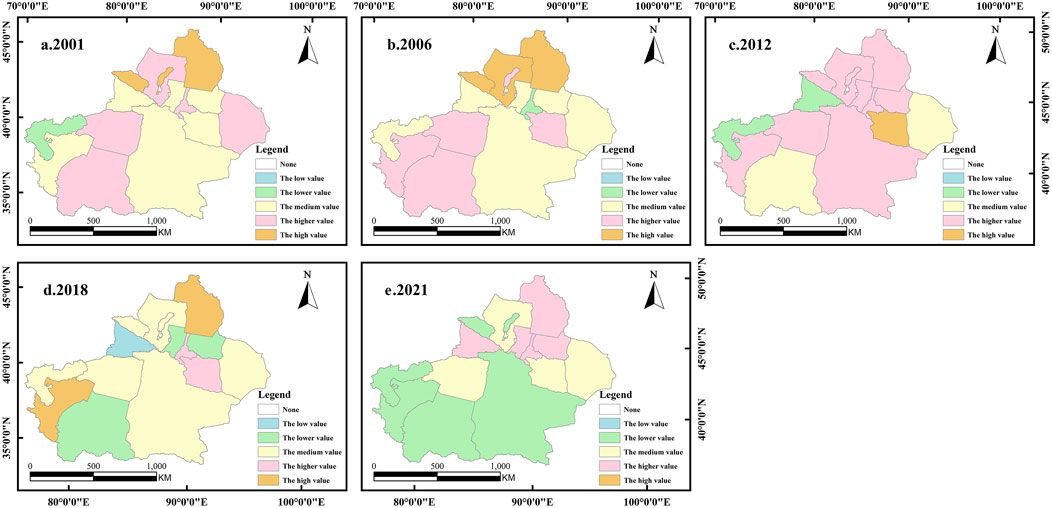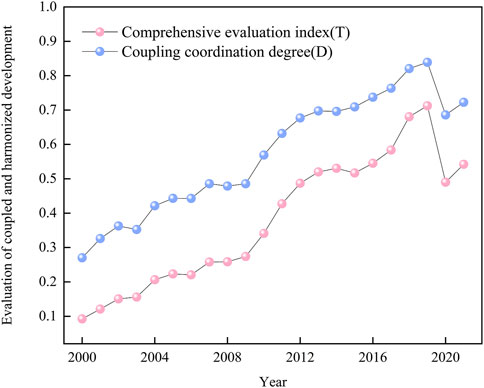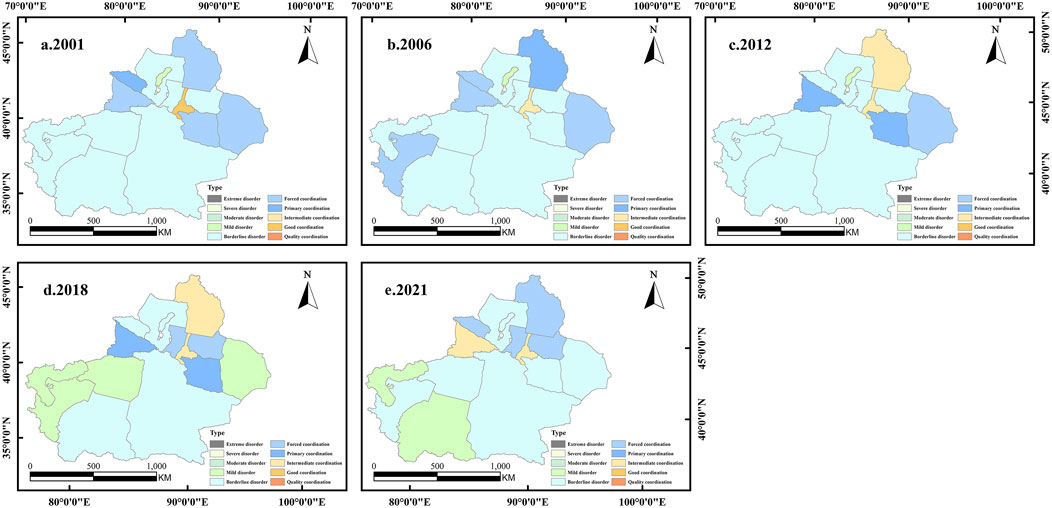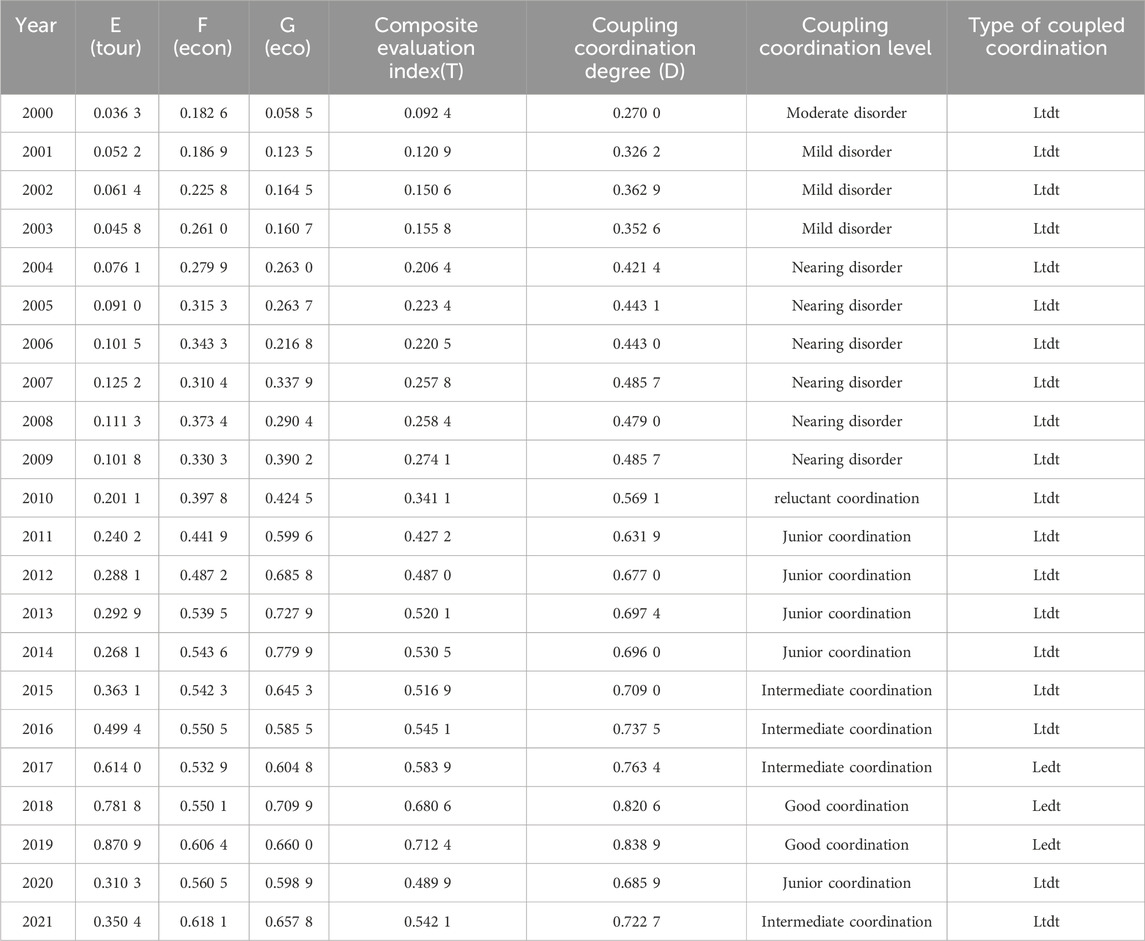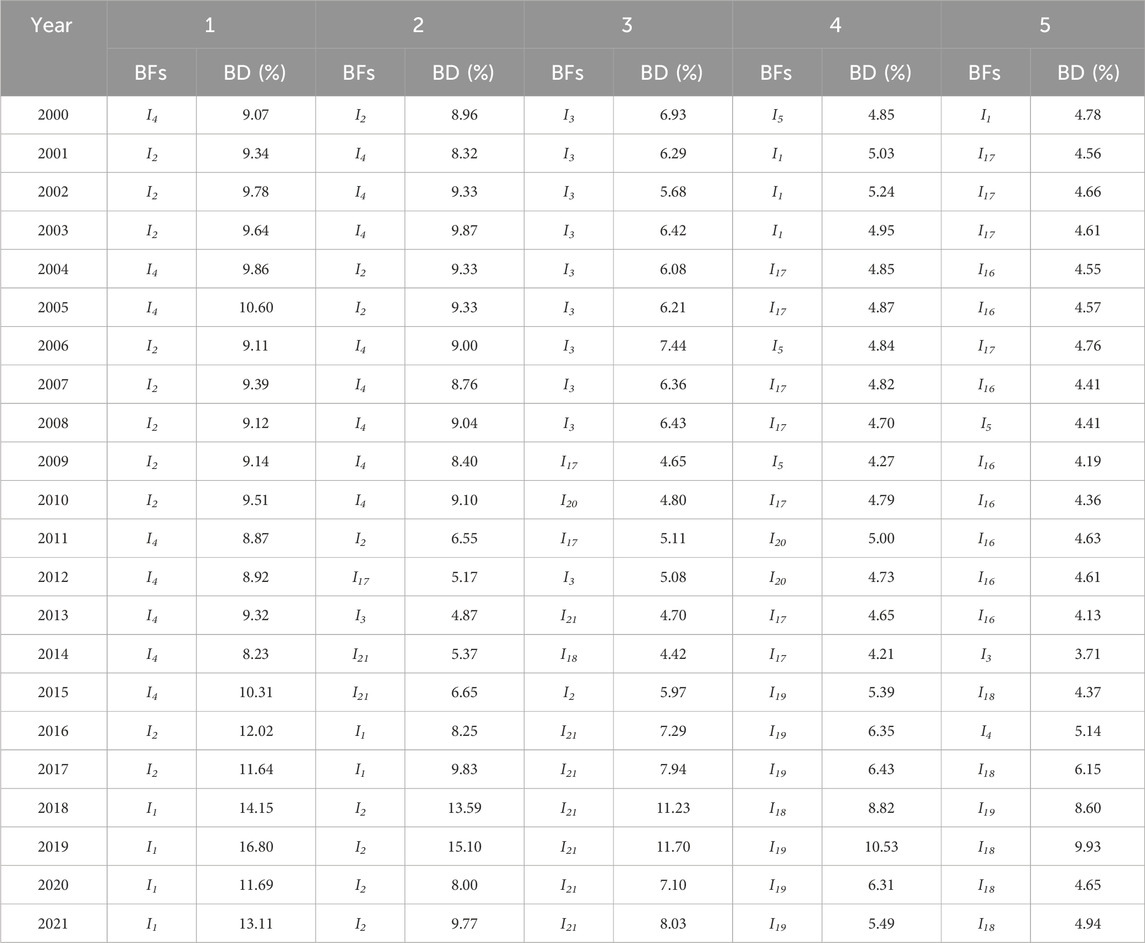- 1Institute of Resources and Ecology, Yili Normal University, Yining, China
- 2College of Resources and Environment, Yili Normal University, Yining, China
- 3School of Geographical Sciences, Southwest University, Chongqing, China
The synergistic integration of tourism, the economy, and the ecological environment within a region is crucial for promoting its sustainable development. Tourism acts as a catalyst for green economic growth, yet varying levels of tourism development can intensify the strain on the ecological environment. Thus, achieving a Pareto optimal balance among the benefits of these three entities holds significant theoretical and practical relevance. This research utilizes statistical data spanning from 2000 to 2021 to devise a tourism-economy-ecological environment (TEE) indicator system for Xinjiang. The study employs a coupled coordination model to analyze the spatial and temporal coupling dynamics between subsystems and to classify the types of coupled coordination. The analysis also identifies obstacles that impede the degree of coordination. The findings indicate that during the period under investigation, the TEE system in Xinjiang experienced consistent growth. However, the tourism subsystem exhibited disparate development and pronounced resource monopolization, which stimulated the economic subsystem’s growth, albeit with noticeable developmental lags in the latter stages. Spatially, economic performance demonstrated a declining trend from core urban centers like Urumqi City and Karamay City towards peripheral areas. From an ecological perspective, the distribution of resources exhibited a heterogeneous “M-V-W” pattern, characterized by significant disparities in the availability of natural resources and the occurrence of localized ecological deterioration. There is a notable and increasing degree of coupled coordination in regional synergistic development, which is primarily manifested in the delayed development of tourism. The combined development of the three subsystems is influenced by some factors, including environmental pollution, resources, economic quality, and industrial structure. Soot emissions, green space per capita in parks, and sulfur dioxide emissions are identified as key constraints. This study provides theoretical backing and empirical evidence for economic growth, the optimization of industrial structure, and the preservation of the ecological environment in arid and semi-arid regions globally.
1 Introduction
As the global tourism industry continues to expand, it is poised to bolster economic growth, consumption, employment, and environmental conservation efforts. Transformations and innovations are anticipated within the transport, utilities, and service sectors (Niewiadomski, 2020). The World Travel and Tourism Council’s Economic Impact Report (2023) projects the industry’s value to reach USD 9.5 trillion in 2023, marking a 5% decrease from pre-pandemic levels in 2019. Tourism remains a significant source of foreign exchange and exports for many developing countries, playing a pivotal role in regional economic development (Du et al., 2016). However, the tourism sector and the global economy have suffered losses and disruptions due to the pandemic. The impacts of COVID-19, due to the inherent vulnerability (Navarro-Drazich and Lorenzo, 2021) of the tourism sector and the lags in industrial recovery, have intensified the challenges of structural advancement and innovation within the sector. “The Belt and Road” initiative, spearheaded by China, has fostered increasing trade interactions among nations along its path, catalyzing growth within the agriculture, communication, and transport industries (Vangeli, 2017). Northwestern China, an integral part of the Silk Road Economic Belt, encompasses provinces such as Xinjiang, Qinghai, Gansu, and Ningxia. It is therefore of the utmost importance that strategies be crafted to advance sustainable tourism, economic growth, and ecological conservation in the western region of China (Zhang et al., 2022). Such strategies are vital for sustaining balance in human-environment interactions within globally recognized ecologically sensitive areas.
Developing countries invest in both sustainable and unsustainable tourism to rapidly boost foreign exchange earnings and employment opportunities (Yfantidou and Matarazzo, 2017). The economic impact of tourism depends on several factors, including its share of the national economy, GDP per capita, the size and structure of the economy, and the level of development of the country (Lee and Chang, 2008). Tourism’s capacity to generate income, employment, and tax revenue plays a crucial role in fueling economic growth and diversifying the industry’s economic framework (Tang and Jang, 2009). It operates within economic and ecological parameters, inevitably causing social, economic, and ecological effects. Against the backdrop of swift economic globalization, industrial volatility, regional resource scarcity, and fluctuating investment climates all influence the progression of national economies (Mustafakulov, 2024). Tourism is considered a sustainable industry due to its high-value addition and low resource demands, including the capital, labor, and natural resources, facilitating a shift towards sustainable economic growth. The dynamic interaction and strong connection among tourism, economic systems, and ecological environments, evolving from simplistic to complex relationships, underscore the importance of examining their integration and alignment (Xiong and Li, 2014). This analysis is crucial for advancing sustainable development within regional economies (Luo et al., 2021).
The majority of these studies have focused on three aspects: (1) Coupling research direction: The coupling research direction in tourism has explored themes like climate change (Scott, 2010), real estate investment (Fereidouni and Masron, 2011), trade (Santana-Gallego et al., 2011), environmental and energy-related challenges (Day and Cai, 2012), and the ecosystem service value (Wang et al., 2022). Similarly, research on economic orientation has focused on natural capital (England, 2000), urbanization processes (Henderson, 2003), trade and property rights (Tajibaeva, 2012), and GDP (Castro-Nuño et al., 2013). In the realm of ecological focus, studies have delved into topics such as ecological evolution (Gössling, 2002), land-use change (Braimoh and Osaki, 2010), ecological footprint (Ozturk et al., 2016), and carbon emissions (Hussain et al., 2022). (2) Measurement of coupling level: The synchronized development of rural town municipalities from socio-economic and infrastructure standpoints (Tomal, 2021). Based on the ecological civilization construction, an evaluation index system was constructed to assess mountainous counties’ populations, economies, and agroecology (Li et al., 2020). Furthermore, it proposed a framework for assessing the vulnerability of mountainous ecological environments and analyzing their development coordination (Xiao et al., 2023). Panel data analysis was employed to investigate the influence of innovation and economic growth on carbon dioxide emissions in both developed and developing countries, with a particular focus on the reduction of regional emissions through the implementation of innovative approaches (Dauda et al., 2019). (3) Coupling mechanism: Tourism has the potential to foster ecological preservation and enhance the environmental quality essential for its growth. The relationship between tourism and the ecological environment is symbiotic, where each can positively influence the other. However, tourism can exert negative pressure on the environment, directly or indirectly impacting ecosystems and exceeding their natural carrying capacities. This overburdening can escalate the costs associated with tourism development and hinder the sector’s growth (Pigram, 1980). The interaction between regional economic growth and tourism development is of pivotal importance. A rapid increase in the economic benefits of a region will accelerate tourism development. However, if the ecological subsystem’s growth lags, it suggests that while economic growth may boost tourism, it also poses risks to the ecological environment (Yin et al., 2023). Scholarly research has predominantly explored the interconnectedness of economic, ecological, societal, innovative, environmental, and urban development, underscoring the necessity for their harmonized progression. This encompasses a focus on the coordination, responsiveness, interactions, and influences within and between these systems (Zhao et al., 2021; Tang et al., 2022; Xu et al., 2023; Yang and Wang, 2023). There remains a paucity of comprehensive analyses on systemic coupling and the formulation of underlying principles. Moreover, assessments of barriers impeding these interrelations are notably absent. The identification and analysis of these developmental impediments will enable insights into the causes of regional imbalances to be uncovered, thus enhancing competitiveness and sustainability.
Xinjiang, situated in the western region of China, serves as a prime example of an arid region, facing the challenges of a dry climate, minimal precipitation, and a delicate ecological system. Official 2021 statistics reveal that the Xinjiang region produced 1,598.365 billion yuan, generated 141.569 billion yuan in tourism revenue, and welcomed 191 million tourists, experiencing a year-on-year tourism revenue increase of 42.69%. Historically serving as a vital passage along the ancient Silk Road, Xinjiang boasts a rich history and unique tourism resources. Nevertheless, the overall development of the tourism industry in the region remains relatively backward, particularly in the ecologically poor southern border areas where the human-land contradiction is unmistakably pronounced. This study seeks to delineate a standard model for integrated development, achieved through the coupled and coordinated advancement of tourism, the economy, and the ecological environment in both the northern and southern borders. The study offers actionable guidance for the development of similar urban agglomerations and regions. The following issues must be addressed to achieve the aforementioned goals: (1) The intrinsic mechanism and feedback dynamics of TEE must be elucidated, as well as the developmental changes and transformation characteristics of its composite system. (2) Policy recommendations must be proposed for coordinated development through coupled coordination models that regularise development dynamics in space and time. (3) Diagnosing the potential problems and challenges of its TEE in the process of dynamic development and change through the obstacle factors, to promote the sustainable development of the region.
2 Rationale and logical framework
2.1 Theoretical foundation
The ecological environment plays a crucial role in the development of the tourism industry and has a significant impact on the economy. It acts as both a support and a constraint (Figure 1). The ecosystem is a critical natural resource that offers essential capital for economic progress. Promoting the tourism industry can be achieved by developing and optimizing natural resources for tourism purposes. Additionally, tourism resources must meet the continuously growing demand of the source market while diversifying and developing at multiple levels (Shu et al., 2015). Secondly, the rapid development of the tourism industry also drives the high-quality development of the regional economy, which lays a good foundation for economic development by optimising the industrial structure and promoting economic transformation. Furthermore, it also promotes the protection and sustainable development of the ecological environment (Tian and Li, 2022). Nevertheless, the development and use of tourism resources will inevitably lead to the destruction of natural resources, such as the construction of tourism facilities and deforestation, the filling of lakes to create landscapes, as well as the destruction of vegetation, water pollution, noise pollution and other problems caused by tourism activities, resulting in environmental pressures and thus irreversible impacts on the ecological environment. Therefore, the tourism industry is not a completely harmless “green industry” (Zou, 2019), and there is a need to promote the development of new forms of tourism, such as ecotourism, to promote the synergistic development between tourism and environmental protection. Finally, the economy fulfills a crucial role in bolstering the expansion of the tourism industry by facilitating construction financing and enhancing public infrastructure. Tourism development can promote sustainable economic growth by using tourism resources rationally (Zhang and Li, 2017). Economic development has inevitably resulted in irreversible environmental damage, encompassing issues like soil erosion (Zhu et al., 2023), water body eutrophication, industrial emissions, and other contributors to environmental deterioration. Hence, high-quality economic advancement requires strict adherence to the fundamental principle of ecological protection, implementing a green development system, and achieving the “lucid waters and lush mountains are invaluable assets”. Consequently, the integrated development of the tourism, economy, the ecological environment represents an indivisible entity, wherein they are mutually interdependent and mutually reinforcing.
2.2 Logical framework
To objectively present the study’s logical framework and research methodology, we developed a comprehensive analytical framework, as shown in Figure 2. The framework addresses three primary aspects: (1) The tourism index, which includes the economic impact and market size of tourism. The economic index is structured based on economic size, economic quality, and industrial composition. The ecological environment index, comprises environmental pollution, environmental resources, and environmental governance. These indices correspond to the tourism, economic and ecological environment subsystems. (2) The CCD model is used to analyze the coordination of the three subsystems. The spatio-temporal evolution of these subsystems is also analyzed, and their type of coordination is further examined. (3) The obstacle degree model is used to analyze the main factors that hinder TEE and identify the obstacles that affect the TEE system.
3 Study area, data sources and research methods
3.1 Study area
Xinjiang, located in the northwest border of China, is one of China’s five ethnic minority autonomous regions and the largest provincial administrative region, with an area of 1.66 million square kilometers, accounting for about one-sixth of the country’s total area. Geographically, Xinjiang ranges from 34°25′N to 48°10′N and 73°40′E to 96°18′E. There are Altay Mountains in the north, Tianshan Mountains in the middle, Kunlun Mountains in the south, and the Tarim Basin and Junggar Basin on both sides of the north and south, forming a topography of “three mountains with two basins” in Xinjiang (Figure 3). By the end of 2023, total retail sales of consumer goods amounted to 384.968 billion yuan, general public budget revenue was 217.97 billion yuan, total import and export of goods amounted to 50.679 billion US dollars, per capita GDP was 73,774 yuan, The urbanization rate was 59.24 percent, the annual per capita disposable income of the residents was 28,947 yuan, there were 265 million visitor arrivals, and the total income from tourism was 296.715 billion yuan. Furthermore, the forest coverage rate was 5.06 percent.
3.2 Data sources
This study investigates 14 prefectural and municipal cities in Xinjiang from 2000 to 2021 focusing on analyzing the tourism industry, economic development, and ecological environment statistics. The primary data sources include the Xinjiang Statistical Yearbook, Fifty Ysears in Xinjiang, China City Statistical Yearbook, and China Ecological Environment Statistical Annual Report. The partial data were gathered from official websites such as the Statistics Bureau of Xinjiang Uygur Autonomous Region, the Xinjiang Uygur Autonomous Region Department of Culture and Tourism, and the Ministry of Ecology and Environment of the People’s Republic of China.
3.3 Research methodology
3.3.1 Construction of the indicator system
Evaluating the coupling relationship between the tourism, economy, and ecological environment, in the Xinjiang region and constructing a scientific and comprehensive evaluation index system are the key steps in measuring the type of coupling coordination. This paper selects indicator factors based on the scientific, typical, comprehensive, operable and data accessibility of indicator selection and refers to the high-frequency indicator factors cited in recent years about the tourism, economy, and ecological environment (Chen et al., 2021; Cao et al., 2022; Zhang et al., 2022; Zhao et al., 2024), and fully combines with the actual situation of the study area to measure the development and change characteristics of the TEE composite system. Based on this, this paper selects 8 factor layers and 21 indicator layers (Table 1) to establish an evaluation index system for the level of coordinated development of the coupled TEE system in Xinjiang, in which the tourism subsystem mainly includes tourism economic efficiency and market scale, reflecting the level of tourism development. The economic subsystem is a reflection of the development of the national economy, as well as the macro-control of the market and the economic system, which mainly includes the economic scale, economic quality and industrial structure. The ecological environment sub-system includes ecological environment pollution, environmental resources, and environmental governance, which reflects the sustainability of the ecological environment as well as its carrying capacity. Due to the existence of quantitative differences between the indicators, to effectively eliminate the error of calculation results, the method of polar deviation is used for the standardisation of data, and then the method of coefficient of variation is applied to calculate the weight of the data.
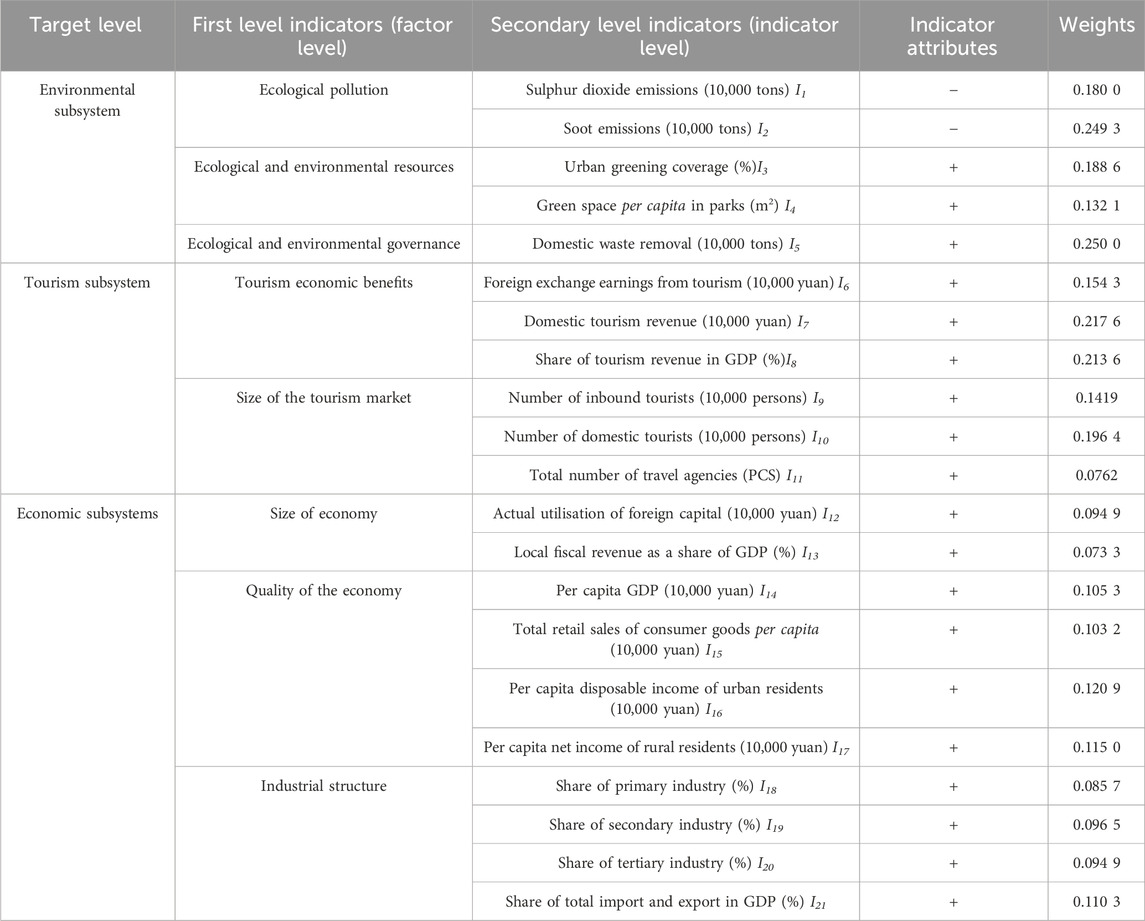
Table 1. Indicator system of coupled tourism-economy-ecological environment coordination degree in Xinjiang.
3.3.2 Data standardization
TEE systems interact with each other. Owing to the existence of quantitative differences between the indicators of tourism, economic, and ecological environment system, as well as the existence of positive and negative indicators. In order to avoid errors in the calculation results, it is necessary to standardise the data. This paper uses the polar deviation method to standardise the data. The data are calculated according to the following formula: there are
Equation 1 is a positive indicator.
Equation 2 is a negative indicator.
The minimum value of the
3.3.3 Variation coefficient method
This paper employs the variation coefficient method to determine the weight of each indicator in the tourism, economic, and ecological environment systems. The coefficient of variation for each indicator is shown in Equation 3.
Equation 4 represents the weight setting.
The formula above calculates
3.3.4 Model test
The comprehensive evaluation index of the tourism system E (tour), the economic system F (econ), and the ecological environment system G (eco) were calculated based on the calculated coefficients of variation and indicator weights. The tourism index is represented by
3.3.5 Coupling coordination degree model
Coupling theory originates from physics and refers to the interaction and influence between two or more systems or modes of movement. It involves a dynamic correlation between interdependent subsystems that promote coordination and dynamic relationships. The formula for calculating the coupling and coordination model of the three tourism, economy, and ecological environments subsystems is derived based on the physical concept of the coupling coefficient model, as described by Equation 8.
The coupling between systems is calculated on a scale of 0–1, where a value closer to 1 indicates a higher degree of coupling. The coupling degree can only explain the level of interaction between subsystems, but it cannot reflect the degree of coupling coordinated development between systems (Gao et al., 2016). To analyze the coordination issue between the tourism, economy, and ecological environment, we introduce the coupling coordination degree formula, as described by Equation 9.
Where C and D are the coupling degree and coupling coordination degree of the three subsystems of regional tourism, economy, and ecological environment, T is the comprehensive index of the overall level of coupling and coordinated development (Equation 10), and α, β and γ are the weights of each system, which promote and constrain each other. Therefore, the tourism subsystem, economic subsystem, and ecological environment subsystem are equally important, so set the pending parameters α = ⅓, β = ⅓, γ = ⅓, as a way to reflect the TEE interaction influence degree in Xinjiang. According to the research results of Liao Chong Bin (Liao, 1999) the evaluation criteria of the coupling coordination degree of subsystems are divided (Table 2).
3.3.6 Barrier degree model
The obstacle degree model is used in this paper to diagnose the main factors that affect the coordinated development of the tourism, economy, and ecological environment in Xinjiang. Three indicators are introduced: degree of divergence of an indicator (
Equation 11 represents the degree of divergence of an indicator.
Equation 12 represents the factor contribution degree.
Equation 13 represents the obstacle degree.
4 Results
4.1 Spatial and temporal characteristics of tourism-economy-ecological environment development level in Xinjiang
4.1.1 Time-series analysis of the level of tourism-economic-ecological environment development
By establishing an evaluation index system for the tourism, economy, and ecological environment and using the coefficient of variation method to calculate the weight of the data, we can obtain three comprehensive evaluation indices for 14 prefectural and municipal cities and towns in Xinjiang from 2000–2021. The results are presented in Figure 4.
The development index of the tourism system significantly influences regional economic growth, though its impact often manifests with a delay. From 2000 to 2007, the composite index saw modest growth, increasing from 0.0363 to 0.1252. Between 2008 and 2018, the tourism evaluation index fluctuated, consistently underperforming compared to the economic and ecological environment system indices. This trend suggests that tourism development frequently compromised the ecological environment, neglecting its carrying capacity in favor of economic advancement. From 2019 to 2021, the tourism evaluation index reached its zenith in 2019 at 0.8708 but declined to 0.3103 in the wake of pandemic effects-a 64.37% decrease. It entered a recovery phase in 2021, rising to 0.3504, marking a 12.92% increase. In 2009, China introduced the Opinions on Speeding up the Development of Tourism, followed by Xinjiang’s establishment of the tourism sector as a strategic pillar industry in 2011. The move facilitated the formation of tourism investment firms, integrating tourism resources and attracting foreign and private investments into Xinjiang’s tourism projects, cultivating a favourable investment climate. Xinjiang’s tourism industry has experienced steady growth from 2014 to 2018, partly thanks to “the Belt and Road” initiative in 2013 and the successful bid for the “Xinjiang Tianshan Mountains” as a heritage site. The tourism industry in Xinjiang is currently experiencing dynamic growth due to major tourism projects that have been developed, creating a positive outlook for the industry. Inbound tourism from Xinjiang has increased from 1,501,000 to 2,626,000 between 2014 and 2018, making it more attractive to foreign investors and private enterprises.
The Economic System Development Index shows a pattern of both stable and volatile upward trends, driven by the region’s robust ecological environment, strong tourism infrastructure, diverse economic policies and influx of foreign investment, all of which contribute to sustainable economic growth with clear benefits for the economy. Between 2000 and 2006, the index gradually increased from 0.182 6 to 0.343 3. From 2007 to 2012, it followed an N-shaped trend, peaking at 0.487 2. Between 2013 and 2016, the trajectory of the index stabilised. From 2017 to 2021, the index showed fluctuating growth, rising from 0.5329 to 0.6064, an increase of 13.79%, before falling to 0.5605 in 2020. In 2021, the Tourism Composite Index returned to its 2019 level, indicating a recovery. The region’s tourism sector faced a setback from 2008 to 2009 amid the global financial crisis, resulting in a dip in domestic tourism revenue from 19.79 billion to 17.67 billion. To mitigate the adverse impacts of the financial crisis, the government implemented various measures to regulate the tourism market, bolster ethnic cultural and folklore tourism, leverage ethnic characteristics to diversify the tourism sector and expand the Southeast Asian source market, all aimed at enhancing the sector’s attractiveness in Xinjiang. In 2015, Xinjiang introduced policies relating to industrial and agricultural production, employment, oil, energy, and other sectors, encompassing 50 measures across 20 domains to stimulate stable and robust economic growth. By 2018, Xinjiang achieved a milestone when its GDP soared to a historical high of 1,219.908 billion yuan, with a per capita GDP of 49,475 yuan, signalling a new chapter in Xinjiang’s economic evolution.
The development index of the ecological environment system showed a fluctuating trend between 2000 and 2021, with periods of both increase and decrease. Throughout this period, as the ecological environment improved, the development of the regional economy and tourism industry consistently improved, highlighting the role of a robust ecological environment as an intangible asset. In particular, the composite index of the ecological environment increased from 0.0585 in 2000 to 0.4245 in 2014. Specifically, an “M” shaped trend (increase-decrease-increase-decrease) from 2000 to 2006 and a “V” shaped trend (decrease-increase) from 2007 to 2014. From 2015 to 2021, the index follows a “W” shaped trend (decrease-increase-decrease-increase), indicating a volatile but progressive improvement. Significant disparities in the development of tourism, the economy and ecosystems persisted until 2014, but then began to converge. Since 2003, Xinjiang has prioritised ecological and environmental issues. The government has implemented the ‘Key Special Plan for Ecological Construction and Environmental Protection in the Autonomous Region’, promoting projects such as reforestation of farmland and improvements in desert management and ecological restoration. These efforts have strengthened ecological protection and compensation mechanisms, contributing significantly to the promotion of ecological civilisation and the gradual reduction of environmental pollution. Such initiatives are crucial to the sustainable development of Xinjiang’s resources and environment.
4.1.2 Analysis of the spatial evolution of the level of integrated tourism-economic-ecological environment development
Based on the analysis of the TEE environment comprehensive development index in the figure, the comprehensive index of the 14 prefectural and municipal cities in Xinjiang can be classified into five categories: The low value, The lower value, The medium value, The higher value, and The high value areas.
4.1.2.1 Analysis of the spatial evolution of the level of development of the tourism subsystem
From 2001 to 2006, regional tourism consistently displayed an upward trend, predominantly in the high-value range (Figure 5). Karamay City transitioned from a low to a lower-value zone in 2006, Altay region (Altay), Kashi region (Kashi), and Hami City (Hami) shifted from a higher to a high-value zone, Yili Kazakh Autonomous Prefecture (Yili) progressed from a medium to a high-value zone, Aksu region (Aksu) advanced from a lower to a medium-value zone, and Hetian region (Hetian) ascended from a medium to a higher-value zone. Subsequently, from 2006 to 2012, regional tourism experienced a decline, primarily moving into lower-value zones. Turpan City rose to a high-value zone in 2012 from a medium one, Bortala Mongolian Autonomous Prefecture (Bo Prefecture) declined to a lower-value zone from a medium zone, Hami shifted to a medium-value zone from a high-value zone, Aksu moved to a lower-value zone from a medium one, Kizilsu Kirgiz Autonomous Prefecture (Ke Prefecture) and Hetian dropped to a medium-value zone from a higher one, and Kashi decreased to a medium-value zone from a high one. From 2012 to 2018, regional tourism notably declined, largely falling into lower-value zones. However, in 2018, Bo Prefecture progressed to a medium-value zone from a lower one, Changji Hui Autonomous Prefecture (Changji) elevated to a high-value zone from a lower one, and Ke Prefecture, Kashi, Hetian, and Hami regressed to lower-value zones from a medium one. From 2018 to 2021, regional tourism shows a clear downward trend, mostly in the lower-value zone: in 2021, Kashi rises from the lower-value zone to the medium-value zone, Altay and Changji fall from the high-value zone to the medium-value zone, and Turpan City falls from the high-value zone to the lower-value zone.
Xinjiang’s tourism industry exhibits uneven development, a generally low overall development level, a noticeable polarization effect, significant regional development disparities, and a pronounced resource monopoly. It relies on its distinctive natural landscapes, local conditions, and customs to allure domestic and international visitors. Noteworthy attractions include the ice and snow tourism city of Altay, the renowned “God’s Own Land” at Wo Mu Village, the captivating “Lake of Changing Colours” at Kanas Lake, and the prestigious world natural heritage site of Xinjiang Tianshan Mountain. However, in 2021, Bayingolin Mongolian Autonomous Prefecture (Ba Prefecture), Aksu, Karamay City, and Tacheng region (Tacheng) were situated at mid-levels of tourism development. These cities, which are heavily reliant on resources, are characterized by a dominance of secondary industries. The emergence of the tourism industry in these areas has been delayed, influenced by factors such as the natural environment, availability of tourist facilities, transportation infrastructure, and geographic location. As social and economic progress unfolds, it has become a well-established trend for resource-based cities to undergo industrial transformation. Moreover, a lack of a distinct “core brand” for tourism development across regions presents a challenge. Consequently, leveraging market diversification efforts to drive rapid growth in the tourism economy and converting regional resource strengths into economic advantages have become pressing issues for resource-based cities.
4.1.2.2 Analysis of the spatial evolution of the level of development of economic subsystems
Figure 6 illustrates the level of economic development during the study period. From 2001 to 2006, the regional economic subsystem is more volatile, with a clear downward trend and mostly lower-value areas. In particular, Karamay City moved from a higher to a high zone in 2006, while Tacheng, Changji, Hami, and Turpan City shifted from a medium-value area to a lower-value area, and Urumqi City fell from a high-value area to a higher-value area. Between 2006 and 2012, the regional economy showed an upward trend, mainly concentrated in higher-value areas. Changji, Hami, Altay and Yili moved from lower to higher-value areas by 2006. Tacheng, Turpan City and Aksu moved from lower to medium value zones, Urumqi City from higher to high-value zones, Ba Prefecture moved from medium to higher value zones, Kashi and Hetian moved from low to lower value zones, Ke Prefectures from low to medium value zones. However, Karamay City moved from a high to a medium-value zone. From 2012 to 2018, the regional economy experienced a significant downturn, with most in the medium-value zone. Karamay City moved from the medium to the high-value zone in 2018. Conversely, Yili, Altay, Changji, Ba Prefecture and Hami dropped from the higher to the medium zone. In addition, Ke Prefecture dropped from the medium to the lower zone, while Kashi fell from the lower-value zone to the low-value zone. From 2018 to 2021, the regional economy is mostly in the medium value zones and at the same level of development as in 2018, while in 2021, Kashi rose from the low to the lower zones and Tacheng fell from the medium to the lower value zone.
In Xinjiang, there are significant disparities in economic levels between different geographical areas, with a noticeable gap between the economic development levels of the northern and southern borders. However, this gap has narrowed over time. Overall, Xinjiang’s economic development shows a lumpy distribution, with clear cases of polarization, diffusion and spatial proximity effects. A spatial aggregation trend tends to occur in areas with higher levels of economic development, with a gradual decline from Urumqi City as the centre to the surrounding areas. Urumqi City, Changji and Karamay City, as the main economic centres in the north, represent the economic integration of the region based on their manufacturing, oil industry and transport infrastructure, giving rise to the characteristics of “Karamay City-Changji-Urumqi City regional economic integration”. Conversely, Ke Prefectures, Kashi, and Hetian regions rely on the Tarim Basin’s oil resources, jade minerals and natural gas fields to develop their urban economies.
4.1.2.3 Analysis of the spatial evolution of the level of development of ecology environment subsystems
Figure 7 illustrates the ecological construction observed during the study period. From 2001 to 2006, the regional ecology consistently showed an upward trend, mostly within the medium-value zone. In 2006, Tacheng shifted from a higher value to a high-value area, while Turpan City and Kashi transitioned from a medium value to a higher-value area. Ke Prefecture moved from a lower-value area to a medium-value area, while Karamay City declined from a high-value area to a higher value. Urumqi City shifted from a higher to a lower value area, and Hami moved from a higher value to a medium value. From 2006 to 2012, there were a significant decline in the regional ecology, particularly in the higher-value zone. In 2012, Urumqi City was upgraded from a lower to a higher value area. Changji and Ba Prefecture also progressed from medium to higher-value areas, and Turpan City improved from a higher value to a high-value area. On the other hand, Ke Prefecture and Yili declined from medium to lower-value areas. Altay, Tacheng, and Bo Prefecture decreased from high to higher value zones, and Hetian downgraded from a higher to a medium value area. From 2012 to 2018, the regional ecology continued to decline, particularly in the medium-value zone. In 2018, Altay and Kashi advanced from higher to high-value areas, Ke Prefecture progressed from lower to medium value, and Yili dropped from lower to low value. Karamay City, Tacheng, Bo Prefecture, Aksu, and Ba Prefecture have transitioned from higher-value to medium-value areas. Changji has shifted from a higher-value area to a lower-value area. Turpan City has improved from a high-value area to a higher-value area, while Hetian has declined from a medium-value area to a lower-value area. From 2018 to 2021, the regional ecology shows a clear downward trend and mostly lower-value zones, and in 2021, Yili rises from a low value zone to a higher value zone, Changji rises from a lower value zone to a higher value zone, Altay falls from a high value zone to a higher value zone, Karamay City falls from a medium value zone to a lower value zone, Bo Prefecture falls from a medium value zone to a lower value zone, and Turpan City falls from a higher value zone to a medium value zone, Ba Prefecture and Ke Prefecture from a medium value zone to a lower value zone, and Kashi from a high value zone to a lower value zone.
In Xinjiang, the natural resources exhibit an uneven spatial distribution, and the ecosystem is delicate. During the study period, local ecological degradation was observed in Changji, Yili, and Hetian. However, these occurrences are currently within the ecological environment’s capacity. Changji, due to its location near Urumqi City, the provincial capital, has become a favoured site for enterprises to establish new operations or relocate. By 2018, the proportion of the secondary industry in Changji had surged to 51.3%, marking a 13.07% increase from 2001. This continuous rise in the secondary industry sector has led to ecological harm. Therefore, it is crucial to prioritize ecological development, promote green and low-carbon initiatives, enforce preventive measures at the source, and enhance the quality and stability of the ecological system. These actions will effectively combat environmental degradation, comply with the laws of industrial evolution, and promote sustainable economic and ecological development.
4.2 Spatio-temporal evolution and type discrimination of coupled tourism-economy-ecological environment coordination in Xinjiang
4.2.1 Coupled coordination degree time series analysis
The paper uses the integrated assessment model and the coupled coordination model. The integrated index T and the coupled coordination degree D were calculated for the three subsystems of Xinjiang tourism, economy, and ecological environment (Figure 8).
The T-value of the composite index indicates that the development of the three subsystems followed a stable growth trajectory throughout the study period. Specifically, the T-value increased steadily from 0.092 4 in 2000 to 0.542 1 in 2021, with a mean of 0.379 0, suggesting mild disorder. The composite index can be divided into four stages. In the initial phase, spanning from 2000 to 2004, the T-value demonstrated a gradual upward trajectory. However, in 2003, the emergence of SARS, coupled with a decline in tourism and the broader economy, resulted in a stagnation of the T-value. During the second stage, spanning from 2005 to 2014, the T-value remained stable, with growth driven mainly by ecological and economic factors. This resulted in a narrowing gap between tourism and economic development. The third stage, spanning from 2015 to 2019, witnessed a marked acceleration in growth, with the T-value increasing from 0.517 0 to 0.712 4, representing a 37.79% increase. This period was characterised by the stabilisation and coordination of development within the tourism industry. The final stage, spanning 2020 and 2021, saw fluctuations in the T-value due to the impact of the COVID-19 pandemic. The value decreased to 0.490 0 in 2020 but subsequently increased to 0.542 0 in 2021.
The coupling coordination degree among tourism, the economy, and the ecological environment in Xinjiang from 2000 to 2021 displayed a consistent upward trend, with an average degree of 0.573 6. This suggests that interactions among the three subsystems were generally positive, as most annual D values showed an increase, indicating a virtuous cycle. Between 2000 and 2009, the coupling degree grew from 0.270 0 to 0.485 7, indicating a relatively low level of coupling. During this period, the interactions between the economy and the ecological environment, as well as between tourism and the ecological environment, were comparatively weak, possibly due to a slower pace in the development of the tourism industry. From 2010 to 2019, the coupling degree significantly increased, rising from 0.569 0 to 0.838 9. This improvement was attributed to the government’s enhanced efforts to support local tourism development through initiatives such as better tourism market management, expanded tourism offerings, increased business revenue, and reduced costs of tourism products. These measures boosted the economic efficiency of the tourism sector. In the 2020–2021 period, the growth rate of the coupling degree slowed, transitioning from junior to intermediate coordination. The innovative economic development model fostered a platform for integrated tourism industry growth, contributing to the promotion of ecological environment management and strengthening the economic impact of tourism. As a result, the sector experienced a gradual stabilization.
4.2.2 Analysis of the spatial evolution of coupled coordination
The coupling coordination degree in Xinjiang exhibited considerable variability between 2001 and 2021, with a mean value of 0.518 0 (Figure 9). During this period, the region experienced a process of synergistic development, although some areas observed a decline in their coupling coordination degree. The spatial pattern exhibited lower coordination in the south and higher coordination in the north. Areas such as Yili, Karamay City, Bo Prefecture, and Changji demonstrated an improving trend from 2000 to 2021. However, Urumqi City, Turpan City, Ke Prefecture, Hetian, and Hami exhibited declines in their levels of coupling and coordination. Factors contributing to this disparity include differences in tourism market structure, product range, industrial base, resource distribution, investment trends, and organisational and managerial frameworks. These factors have impeded the growth of the tourism sector and economy, resulting in varying degrees of coordinated development across regions. Urumqi, a political, economic, and cultural centre, has demonstrated consistent coupled and coordinated development. Its unique location, tourism product development, transport infrastructure, industry transfers, intercity cooperation, and talent exchanges have facilitated significant regional synergy, thereby fostering the priority development of regions like Altay, Karamay City, Changji, Yili, and Turpan City. The southern regions of Hetian and Aksu, despite their mineral and oil wealth, have a weaker economic base, underdeveloped transport infrastructure, lower urbanisation levels, and less economic freedom. These factors create a significant gap in the level of coordinated development among the tourism, economic, and ecological environment sectors compared with northern regions like Urumqi City, Changji, and Karamay City. This has contributed to a spatially polarised pattern in the region.
4.2.3 Coupling coordination type discrimination
The shift from moderate disorder - mild disorder - nearing disorder - reluctant coordination - junior coordination - intermediate coordination - good coordination in the coupling level indicates a significant improvement in the overall coordinated development of Xinjiang’s tourism, economic, and ecological environment system. Based on the standard classification for coupling coordination levels, the primary type of subsystem coupling coordination is the lagging tourism development type (Ltdt) (Table 3). The period from 2000 to 2016 was characterised by a lack of progress in the tourism sector, which transitioned from a state of moderate disorder to intermediate coordination. The coupling coordination degree ranged from 0.27 to 0.74, with an average of 0.516 9. The ecological subsystem demonstrated superior performance to the economic subsystem, highlighting the favourable ecological conditions present in Xinjiang. However, economic growth was sluggish, and tourism resources were underutilised, suggesting significant potential for enhancing Xinjiang’s long-term tourism and economic performance. From 2017 to 2019, the dynamic shifted from lagging tourism development to lagging economic development type (Ledt). Although initially the tourism industry trailed behind economic developments, the coupling and coordination degree advanced from intermediate to good coordination. Nevertheless, the rapid growth of the tourism sector exceeded the ecosystem’s carrying capacity, indicating that this expansion came at the expense of substantial natural resource consumption. Consequently, these resources were not effectively managed or utilised, leading to considerable ecological damage. During the 2020 and 2021 period, the coupling coordination transitioned from an economic development lagging to a tourism development lagging type, and the coordination level evolved from junior to intermediate. The narrowing gap between the economic subsystem and the ecological subsystem indicates that economic development now adequately incorporates ecological standards. The tourism sector was severely impacted by the pandemic, resulting in significant disruptions and halting further development and planning (Mishchuk et al., 2023). To guarantee the uninterrupted, robust, and wholesome advancement of the tourism, economy, and ecological environment, the implementation of comprehensive policy measures is of paramount importance.
4.3 Diagnosis of coupled coordination disorder factors
A data set spanning from 2000 to 2021 was analysed in order to identify barrier factors (BFs) affecting the coupling coordination of Xinjiang’s tourism, economy, and ecological environment. Using raw data and a barrier degree model, this analysis quantified the impact of various indicators on the coordination of the three subsystems, ranked the indicators according to their barrier degree (BD), and identified significant barriers over time (Table 4). From 2000 to 2010, the primary barriers included particulate soot emissions (I2), urban greening coverage (I3), green space per capita in parks (I4), per capita disposable income of urban residents (I16), and per capita net income of rural residents (I17). For the period 2011 to 2021, the most significant barriers shifted to include sulfur dioxide emissions (I1), particulate soot emissions (I2), green space per capita in parks (I4), the share of primary industry (I18), the share of secondary industry (I19), and the share of total import and export in GDP (I21). Overall, the following factors emerged as significant barriers: Sulfur dioxide emissions (I1), soot emissions (I2), green space per capita in parks (I4), per capita net income of rural residents (I17), and the share of total import and export in GDP (I21). These findings suggest that environmental pollution, resource management, economic quality, and industrial structure are critical constraints to the harmonious development of Xinjiang’s tourism, economy, and ecological environment.
There are marked ecological disparities between northern and southern Xinjiang, with differing ecological sunk costs. Cities with fragile ecosystems tend to pursue extensive economic development strategies, which can lead to industrial pollution and increased environmental stress. This can exceed the carrying capacity of the ecosystems and impede coordinated economic and ecological development. Rapid urban expansion increases the demand for construction land, which can result in reduced forest and grassland coverage and squeezed green and ecological spaces. As societal development progresses, there is a growing demand for better environmental quality and more ecological space. To reconcile the pursuit of a high-quality life with the availability of green spaces, policies protecting green spaces have been implemented, raising public awareness of grassland and forest conservation. Local rural residents are primarily engaged in agriculture and livestock farming, with unstable and limited income sources. As the economy and urbanisation rapidly advance, more rural residents migrate to cities seeking new employment opportunities. However, due to an imperfect local economic and industrial structure, low-skilled positions predominate in the secondary and tertiary sectors, leading to low income levels and extensive livelihood strategies, which hinder regional economic growth, consumption upgrading, and environmental protection. Xinjiang’s economy, overly reliant on fixed asset investment and dependent on external support for development, faces economic path dependency, which hampers sustainable regional economic growth.
5 Discussion
5.1 Selection of tourism-economic-ecological environment sustainable development strategy in Xinjiang
A number of factors play a role in the regional TEE. The greatest barrier to coordinated development is soot emissions, followed by green space per capita in parks, sulfur dioxide emissions, and total imports and exports as a proportion of GDP. Reducing soot and sulfur dioxide emissions is crucial to improving urban environmental quality and maintaining ecological balance. Efforts to increase green space can significantly contribute to regional economic growth and ecological protection, ultimately boosting tourism revenue. Furthermore, a greater proportion of imports and exports in GDP can enhance the resilience and sustainability of economic development. Through policy initiatives that address tourism, the economy, and the ecological environment, the sustainable growth and coordination of the regional TEE can be achieved.
(1) Carbon peaking and carbon neutrality
Promoting carbon peaking and carbon neutrality is a key priority. To achieve these goals, the focus should be on attracting talent, foreign investment, and fostering innovation. This approach will drive the development of high-tech industries and promote the transition from primary and secondary industries to tertiary industries. Effective use of natural resources, alongside the clean and efficient use of coal, can aid in harnessing resource advantages. The development of renewable energy sources like wind, hydro, photovoltaic power, and natural gas will support cleaner energy production.
(2) Core area of the Silk Road Economic Belt
With the construction of “one port, two districts, five centres and a port economic belt” as the main line, it is striving to broaden the breadth and depth of the construction of “the Belt, and Road” outwardly, and to deepen economic, trade and investment cooperation with the neighbouring countries by building a strategic positioning such as the golden corridor between Asia and Europe and the bridgehead for opening up to the west, and by adjusting new action strategies in accordance with the new winds of domestic and foreign development.
(3) Path of green wedge management
Comprehensive ecological zoning and prioritization of ecological protection areas are crucial. Identifying priority ecological protection units, focusing on maintaining ecological red lines, and integrating intelligent ecological management with environmental protection are key strategies. Proper planning of green wedges can lead to high-quality green spaces, the protection of natural landscapes and biodiversity, and stability in local ecosystems.
(4) Accelerating the integration of “high-speed rail-air-tourism” resources
Promoting transport and tourism information technology can improve accessibility to scenic spots, facilitating a dense high-speed rail-air transport network with Urumqi as the central hub. Constructing multi-tourist routes, such as “Urumqi City-Yili-Altay-Turpan City,” can boost tourism and promote broader regional development through a positive ripple effect. The advancement of regional economies will facilitate economic and social progress, thereby establishing a unified and sustainable growth trajectory.
5.2 Heterogeneity analysis of tourism-economy-ecological environment in Xinjiang
This study analyses the uneven growth of the tourism sector in Xinjiang, which exhibits significant disparities among its regions. Altay, Yili, and Urumqi City are particularly appealing to local and international visitors due to their unique natural landscapes and cultural heritage. The research identifies a clear resource monopoly within Xinjiang’s tourism industry, consistent with the resource-centric phase that characterizes the region’s tourism sector (Liu et al., 2022). According to recent research by Miao Xin Ping (Miao and Xie, 2023), the development of the tourism industry is hindering the coordinated progress of the Xinjiang region. For this reason, Xinjiang’s tourism and ecological sectors are developing hysteresis. During the initial stages of development, the tourism industry may encounter inefficiencies as it strives to integrate available resources effectively and leverage them for economic benefits. The lack of industrial clustering dynamics primarily hinders the industry’s development level and efficiency when aiming for synergistic coordination between industry, resources, and the economy. To maximize the dynamic impact of these entities and harmonize them with Xinjiang’s tourism, fully utilize their dynamic effects to fit the current tourism demand pattern and promote the stable development of the tourism economy.
Tourism, a highly dynamic industry, increasingly jeopardizes the resilience of regional ecosystems through continuous natural resource exploitation, simultaneously diminishing the development potential of the tourism economy. However, heterogeneity is evident across arid and semi-arid regions, influenced by diverse geographic effects, transportation availability, and urbanization levels. Firstly, arid and semi-arid zones globally feature unique geographic characteristics shaped by dry climates, desert landscapes, and water scarcity, all of which contribute directly to ecological vulnerability (Zhu et al., 2023). Secondly, there is a significant variation in transportation accessibility across different countries and regions. The aggregation of tourism resources in major urban centres and economically developed areas is driven by the evolution of local economies, economic networks, and urbanisation, which shows a strong positive correlation with transportation accessibility. Thirdly, urbanisation serves as a critical indicator of social development, influencing the concentration of production factors, resource allocation, and economic capital accumulation, which in turn affects urbanisation’s heterogeneity. In light of these considerations, it is of paramount importance for countries and regions to assess their specific geographic, transportation, and urbanization constraints when striving for coordinated development among TEE. The promotion of sustainable regional development necessitates the selection and implementation of appropriate management systems, planning models, infrastructure construction, and regional development strategies that support this integrated approach.
5.3 Limitations and perspectives
Due to the varying research subjects and perspectives, the construction of the indicator system varies based on the method used to evaluate the coupled coordination system. In recent developments concerning the TEE environment, the indicator system predominantly encompasses elements such as production technology, consumption levels, service facilities, ecological assets, and foreign investment (Zhou et al., 2016; Zhao et al., 2020). In order to gain a comprehensive understanding of the coupled coordination system, it is essential to analyse the factor layer from multiple perspectives, including society, economy, ecology, tourism, culture, transportation, urbanisation, and science and technology. This breakdown facilitates the characterisation of the indicator layer by aspects such as effect, investment, production, scale, and resources, which play a crucial role in analysing coupled coordination and identifying obstacles. This paper advances existing research by leveraging the endogenous mechanisms of the TEE system to construct a comprehensive indicator system that integrates dimensions of tourism, economy, and ecological environment. The utilisation of this system enables the effective screening of factor layer indicators that influence the coupling of regional subsystems during their interaction with nature, industry, market, and policy. This methodology enhances the precision in reversing the measurement results of the coupling process and mechanisms among the regional tourism, economy, and ecological environment subsystems.
This paper employs spatial technology methods, a coupled coordination degree model, and a barrier degree model to quantitatively analyse the interconnected relationship among the tourism, economy, and ecological environment. Prior to developing the indicator system, a comprehensive evaluation of the symbiotic relationships among factors is conducted, with the selection of indicators that effectively capture regional disparities. The interaction between human and natural systems displays complex characteristics over time and space, manifesting legacy effects, time lags, elasticity, and heterogeneity (Liu et al., 2007). This interdependence between human activities and natural spaces has, through socio-economic and environmental interactions across vast distances (Liu and Yang, 2013), prompted changes in natural spatial structures, impacting regional and global earth systems. These dynamics underscore the escalating human-earth conflicts. Future research should integrate human production activities more thoroughly from a behavioural perspective. It should examine the evolution and mechanisms of human-earth relations under the framework of long-distance interaction coupling and explore how individual actors, decision-making processes, national policies, and socio-cultural factors influence the TEE nexus at a micro-level. This study addresses the coupling and coordination within these interconnected domains.
6 Conclusion
This paper presents a coupled TEE environment evaluation system. It delves into the interactions between the subsystems, establishes a coupled coordination degree model, and calculates the coordination levels among the three subsystems. Additionally, it employs an obstacle degree model to identify the primary barriers impacting regional coupling. The study concludes.
(1) Temporal Development Trends: Initially, the tourism system’s development index shows a gradual increase, significantly driven by the regional economic system. However, the rate of tourism development begins to slow down in later stages. The economic system’s development level rises significantly, showing a stable, yet fluctuating upward trend. The ecological environment system in Xinjiang displays an “M-V-W″ pattern, characterised by fluctuating trends but maintaining an overall upward trajectory.
(2) Spatial Development Patterns: The tourism system demonstrates a notably lower degree of development, characterised by marked polarisation, significant inter-regional disparities in development, and a pronounced concentration of resources. The economic system is clustered, demonstrating clear polarization, diffusion, and geospatial proximity effects. Economic development is most concentrated Urumqi City and Karamay City, with a decreasing gradient moving outward from these cities. Regarding the spatial arrangement of the ecological environment system, there is a pronounced imbalance in the distribution of natural resources. Certain areas, including Changji, Yili, and Hetian, are experiencing notable environmental degradation and damage, highlighting the spatial imbalances within this subsystem.
(3) Composite Index Analysis: The T-value of the composite index indicates that the overall development level of the tourism, economy, and ecological environment subsystems has remained stable throughout the study period. Temporal analysis reveals a stable overall growth trend in the coupling coordination degree between these subsystems, with increasing interaction and a generally upward trajectory of D-values, indicating a beneficial cycle. Spatial analysis indicates that while the region displays characteristics of synergistic development, some areas exhibit a decline in coupling coordination degree. In general, spatial patterns indicate lower coordination degrees in the south and higher in the north.
(4) Evolution of Coordination Degree: The evolution of the coupling coordination degree in the Xinjiang TEE environment system progresses through stages from moderate disorder, mild disorder, nearing disorder, reluctant coordination, junior coordination, to intermediate and good coordination. The transition to good coordination marks a significant improvement in the overall level of coordinated development, predominantly characterised by lag in tourism development. The principal barriers to coordinated development include sulfur dioxide emissions, soot emissions, green space per capita in parks, per capita net income of rural residents, and the share of total import and export in GDP. These barriers are distributed across different factor layers, suggesting that impediments to Xinjiang’s coordinated development arise from complex interactions among various indicators.
Data availability statement
The original contributions presented in the study are included in the article/supplementary material, further inquiries can be directed to the corresponding authors.
Author contributions
HL: Data curation, Funding acquisition, Project administration, Resources, Validation, Visualization, Writing–review and editing, Writing–original draft. BC: Conceptualization, Formal Analysis, Methodology, Software, Writing–original draft. QX: Conceptualization, Data curation, Methodology, Supervision, Validation, Writing–review and editing. GZ: Conceptualization, Formal Analysis, Investigation, Methodology, Software, Supervision, Writing–original draft. GL: Data curation, Investigation, Methodology, Project administration, Resources, Supervision, Validation, Visualization, Writing–review and editing.
Funding
The author(s) declare that financial support was received for the research, authorship, and/or publication of this article. This research was financially supported by “National Social Science Foundation West Project” (Grant number 23XMZ068), “The “Belt and Road” Special Research Base of the Department of Education of Xinjiang Uygur Autonomous Region Open Project of the “Belt and Road” Development Research Centre of Yili Normal University” (Grant number YDYL2023ZD006) and “Major Research Projects of Yili Normal University” (Grant number 2023ZDZX002).
Acknowledgments
Its draft has been released in the form of preprint in the Research Square, https://www.researchsquare.com/article/rs-4336006/v1, https://doi.org/10.21203/rs.3.rs-4336006/v1, but it has not been peer reviewed by a journal and will not affect the publication.
Conflict of interest
The authors declare that the research was conducted in the absence of any commercial or financial relationships that could be construed as a potential conflict of interest.
Correction note
A correction has been made to this article. Details can be found at: 10.3389/fenvs.2025.1633224.
Publisher’s note
All claims expressed in this article are solely those of the authors and do not necessarily represent those of their affiliated organizations, or those of the publisher, the editors and the reviewers. Any product that may be evaluated in this article, or claim that may be made by its manufacturer, is not guaranteed or endorsed by the publisher.
References
Braimoh, A. K., and Osaki, M. (2010). Land—use change and environmental sustainability. Sustain. Sci. 5, 5–7. doi:10.1007/s11625-009-0092-2
Cao, Y., Jiang, A. Y., Cao, Z. J., Fayyaz, A., Li, J., Chen, W. Q., et al. (2022). Impact of the belt and road initiative on economic-social-natural ecological niches and their coupling coordination: evidence from 11 countries along the route. Front. Environ. Sci. 10. doi:10.3389/fenvs.2022.913928
Castro-Nuño, M., Molina-Toucedo, J. A., and Pablo-Romero, M. P. (2013). Tourism and GDP: a meta—analysis of panel data studies. J. Travel Res. 52, 745–758. doi:10.1177/0047287513478500
Chen, Q., Bi, Y. Z., and Li, J. F. (2021). Spatial disparity and influencing factors of coupling coordination development of Economy-Environment-Tourism-Traffic: a case study in the middle reaches of Yangtze River Urban Agglomerations. Int. J. Environ. Res. Public Health 18, 7947. doi:10.3390/ijerph18157947
Dauda, L., Long, X. L., Mensah, C. N., and Salman, M. (2019). The effects of economic growth and innovation on CO2 emissions in different regions. Environ. Sci. Pollut. Res. 26, 15028–15038. doi:10.1007/s11356-019-04891-y
Day, J., and Cai, L. (2012). Environmental and energy-related challenges to sustainable tourism in the United States and China. Int. J. Sustain. Dev. World Ecol. 19, 379–388. doi:10.1080/13504509.2012.675600
Du, D., Lew, A. A., and Ng, P. T. (2016). Tourism and economic growth. J. Travel Res. 55, 454–464. doi:10.1177/0047287514563167
England, R. W. (2000). Natural capital and the theory of economic growth. Ecol. Econ. 34, 425–431. doi:10.1016/s0921-8009(00)00187-7
Fereidouni, H. G., and Masron, T. A. (2011). The effect of tourism agglomeration on foreign real estate investment: evidence from selected oecd countries/turizmo aglomeracijos poveikis užsienio investicijoms į nekilnojamąjį turtą: įrodymai iš atrinktų ebpo šalių. Int. J. Strategic Prop. Manag. 15, 222–230. doi:10.3846/1648715x.2011.613241
Gao, Y., Ma, Y. F., and Liu, J. S. (2016). Study on the coupling coordinative development and types among tourism, urbanization and ecological system: a case study of Beijing Tianjin-Hebei area. J. Shanxi Normal Univ. Sci. Ed. 44, 109–118. doi:10.15983/j.cnki.jsnu.2016.05.453
Gössling, S. (2002). Global environmental consequences of tourism. Glob. Environ. Change 12, 283–302. doi:10.1016/s0959-3780(02)00044-4
Henderson, V. (2003). The urbanization process and economic growth: the so—what question. J. Econ. growth 8, 47–71. doi:10.1023/a:1022860800744
Hussain, M., Mir, G. M., Usman, M., Ye, C., and Mansoor, S. (2022). Analysing the role of environment—related technologies and carbon emissions in emerging economies: a step towards sustainable development. Environ. Technol. 43, 367–375. doi:10.1080/09593330.2020.1788171
Lee, C. C., and Chang, C. P. (2008). Tourism development and economic growth: a closer look at panels. Tour. Manag. 29, 180–192. doi:10.1016/j.tourman.2007.02.013
Li, Q. Y., Zhu, L. Q., and Wang, J. Y. (2020). Coordination degree among the tourism—economy—society—ecology system of Jilin Province under the background of all—for—one tourism. Sci. Geogr. Sin. 40, 948–955. doi:10.13249/j.cnki.sgs.2020.06.010
Liao, C. B. (1999). Quantitaitve judgement and classification system for coordinated development of environment and economy—a case study of the city group in the Pearl River Delta. Trop. Geogr., 76–82. doi:10.3969/j.issn.1001-5221.1999.02.013
Liu, H. J., Hasan, M., Cui, D., Yan, J. J., and Sun, G. J. (2022). Evaluation of tourism competitiveness and mechanisms of spatial differentiation in Xinjiang, China. Plos One 17, e0263229. doi:10.1371/journal.pone.0263229
Liu, J. G., Dietz, T., Carpenter, S. R., Alberti, M., Folke, C., Moran, E., et al. (2007). Complexity of coupled human and natural systems. Science 317, 1513–1516. doi:10.1126/science.1144004
Liu, J. G., and Yang, W. (2013). Integrated assessments of payments for ecosystem services programs. Proc. Natl. Acad. Sci. U. S. A. 110, 16297–16298. doi:10.1073/pnas.1316036110
Luo, S. F., Meng, S. Y., and Huang, Y. L. (2021). A study on the spatiotemporal coupling relationship of ecological, tourism and rural revitalization in Minority areas. Ecol. Econ. 37, 135–144.
Miao, X. P., and Xie, X. M. (2023). Study on the analysis of the coordinated development trend of provincial and regional economy—ecological environment—tourism industry and obstacle degree. Hubei Agric. Sci. 62, 223–230+250. doi:10.14088/j.cnki.issn0439-8114.2023.08.035
Mishchuk, H., Czarkowski, J. J., Neverkovets, A., and Lukács, E. (2023). Ensuring sustainable development in light of pandemic “New Normal” influence. Sustainability 15, 13979. doi:10.3390/su151813979
Mustafakulov, S. (2024). Impact of globalisation on economic growth and investment attractiveness of regions, 1. Germany: Nordic_Press.
Navarro-Drazich, D., and Lorenzo, C. (2021). Sensitivity and vulnerability of international tourism by covid crisis: south America in context. Res. Glob. 3, 100042. doi:10.1016/j.resglo.2021.100042
Niewiadomski, P. (2020). COVID-19: from temporary de-globalisation to a re-discovery of tourism? Tour. Geogr. 22, 651–656. doi:10.1080/14616688.2020.1757749
Ozturk, I., Al-Mulali, U., and Saboori, B. (2016). Investigating the environmental Kuznets curve hypothesis: the role of tourism and ecological footprint. Environ. Sci. Pollut. Res. 23, 1916–1928. doi:10.1007/s11356-015-5447-x
Pigram, J. J. (1980). Environmental implications of tourism development. Ann. Tour. Res. 7, 554–583. doi:10.1016/0160-7383(80)90049-3
Santana-Gallego, M., Ledesma-Rodriguez, F., and Perez-Rodriguez, J. V. (2011). Tourism and trade in OECD countries. A dynamic heterogeneous panel data analysis. Empir. Econ. 41, 533–554. doi:10.1007/s00181-011-0477-9
Scott, D. (2010). Why sustainable tourism must address climate change. J. Sustain. Tour. 19, 17–34. doi:10.1080/09669582.2010.539694
Shu, X. L., Gao, Y. B., Zhang, Y. X., and Yang, C. Y. (2015). Study on the coupling relationship and coordinative development between tourism industry and eco-civilization city. China Popul. Resour. Environ. 25, 82–90. doi:10.3969/j.issn.1002-2104.2015.03.01
Tajibaeva, L. S. (2012). Property rights, renewable resources and economic development. Environ. Resour. Econ. 51, 23–41. doi:10.1007/s10640-011-9486-6
Tang, C. H., and Jang, S. (2009). The tourism-economy causality in the United States: a sub-industry level examination. Tour. Manag. 30, 553–558. doi:10.1016/j.tourman.2008.09.009
Tang, F., Wang, L., Guo, Y. Q., Fu, M. C., Huang, N., Duan, W. S., et al. (2022). Spatio-temporal variation and coupling coordination relationship between urbanisation and habitat quality in the Grand Canal, China. Land Use Policy 117, 106119. doi:10.1016/j.landusepol.2022.106119
Tian, J., and Li, J. (2022). Analysis and treatment of the conflict between sustainable development and environmental protection based on the ecotourism concept. Front. Environ. Sci. 10. doi:10.3389/fenvs.2022.1056643
Tomal, M. (2021). Analysing the coupling coordination degree of socio-economic-infrastructural development and its obstacles: the case study of Polish rural municipalities. Appl. Econ. Lett. 28, 1098–1103. doi:10.1080/13504851.2020.1798341
Vangeli, A. (2017). China's engagement with the sixteen countries of central, east and Southeast Europe under the belt and road initiative. China and World Econ. 25, 101–124. doi:10.1111/cwe.12216
Wang, B., Hu, C. G., and Li, J. X. (2022). Coupling and coordination relationship between the tourism economy and ecosystem service value in Southern Jiangsu, China. Int. J. Environ. Res. Public Health 19, 16136. doi:10.3390/ijerph192316136
Xiao, H., Shao, H. Y., Long, J. M., Zhang, S. H., He, S., and Wang, D. (2023). Spatial-temporal pattern evolution and geological influence factors analysis of ecological vulnerability in Western Sichuan mountain region. Ecol. Indic. 155, 110980. doi:10.1016/j.ecolind.2023.110980
Xiong, Y., and Li, C. L. (2014). Synthetic evaluation on coordinated of tourism—economy—ecological system in Zhangjiajie City. China Popul. Resour. Environ. 24, 246–250.
Xu, X., Wang, M. M., Wang, M. F., Yang, Y. C., and Wang, Y. L. (2023). The coupling coordination degree of economic, social and ecological resilience of Urban Agglomerations in China. Int. J. Environ. Res. Public Health 20, 413. doi:10.3390/ijerph20010413
Yang, J. J., and Wang, T. (2023). Synergistic effects of technological innovation, industrial structure upgrading, and ecological environment optimization-evidence from China. Front. Ecol. Evol. 11. doi:10.3389/fevo.2023.1039865
Yfantidou, G., and Matarazzo, M. (2017). The Future of sustainable tourism in developing countries. Sustain. Dev. 25, 459–466. doi:10.1002/sd.1655
Yin, Z. X., Tang, Y. L., Liu, H. N., and Dai, L. Y. (2023). Coupling coordination relationship between tourism economy-social welfare-ecological environment: empirical analysis of Western Area, China. Ecol. Indic. 155, 110938. doi:10.1016/j.ecolind.2023.110938
Zhang, A. R., and Li, Z. M. (2017). Research on the effects of tourism development on Economic growth of Tibet. J. Tibet Univ. Soc. Sci. 32, 131–136. doi:10.16249/j.cnki.1005-5738.2017.04.019
Zhang, F. T., Sarker, M. N. I., and Lv, Y. (2022a). Coupling coordination of the regional economy, tourism industry, and the ecological environment: evidence from Western China. Sustainability 14, 1654. doi:10.3390/su14031654
Zhang, Z., Qin, J. X., Luo, L., and Feng, Y. X. (2022b). Research on the evaluation of coordinated development of tourism-economy-ecological environment along the Silk road economic belt. Sustainability 14, 13838. doi:10.3390/su142113838
Zhao, H. L., Yang, Z. P., Han, F., Shi, H., Wang, C. R., and Guo, J. J. (2020). Analysis and forecast of coupling situation among tourism industry-economic development—ecological environment in Xinjiang. Arid. Land Geogr. 43, 1146–1154. doi:10.12118/j.issn.1000-6060.2020.04.30
Zhao, X. Y., Sun, H. J., Hu, J. L., Xie, Y. X., Zhao, P. K., and Sui, Q. Q. (2024). Study on the coordinated development of tourism industry-regional economy-ecological environment in the Yili river valley. Sustainability 16, 1815. doi:10.3390/su16051815
Zhao, Y. H., Hou, P., Jiang, J. B., Zhai, J., Chen, Y., Wang, Y. C., et al. (2021). Coordination study on ecological and economic coupling of the Yellow River Basin. Int. J. Environ. Res. Public Health 18, 10664. doi:10.3390/ijerph182010664
Zhou, C., Feng, X. G., and Tang, R. (2016). Analysis and forecast of coupling coordination development among the regional economy—ecological environment—tourism industry—a case study of Provinces along the Yangtze economic zone. Econ. Geogr. 36, 186–193. doi:10.15957/j.cnki.jjdl.2016.03.025
Zhu, H. H., Du, M. L., and Yin, X. J. (2023a). Oasification in arid and semi-arid regions of China: new changes and Re-examination. Sustainability 15, 3335. doi:10.3390/su15043335
Zhu, K., Cheng, Y. F., Zang, W. Y., Zhou, Q., El Archi, Y., Mousazadeh, H., et al. (2023b). Multiscenario simulation of land-use change in hubei province, China based on the markov-FLUS model. Land 12, 744. doi:10.3390/land12040744
Keywords: tourism, economy, ecological environment, coupling coordination, barrier factors
Citation: Liu H, Chen B, Xia Q, Zabi G and Li G (2024) Study on the complex relationship of tourism-economy-ecological environment in arid zones: the case of Xinjiang, China. Front. Environ. Sci. 12:1435660. doi: 10.3389/fenvs.2024.1435660
Received: 20 May 2024; Accepted: 30 September 2024;
Published: 15 October 2024; Corrected: 27 June 2025.
Edited by:
Marco Casazza, University of Salerno, ItalyReviewed by:
Kai Liu, Shandong Normal University, ChinaLóránt Dénes Dr. Dávid, John von Neumann University, Hungary
Copyright © 2024 Liu, Chen, Xia, Zabi and Li. This is an open-access article distributed under the terms of the Creative Commons Attribution License (CC BY). The use, distribution or reproduction in other forums is permitted, provided the original author(s) and the copyright owner(s) are credited and that the original publication in this journal is cited, in accordance with accepted academic practice. No use, distribution or reproduction is permitted which does not comply with these terms.
*Correspondence: Beizi Chen, Y2MwOTY3MEAxNjMuY29t
 Haijun Liu1,2,3
Haijun Liu1,2,3 Beizi Chen
Beizi Chen